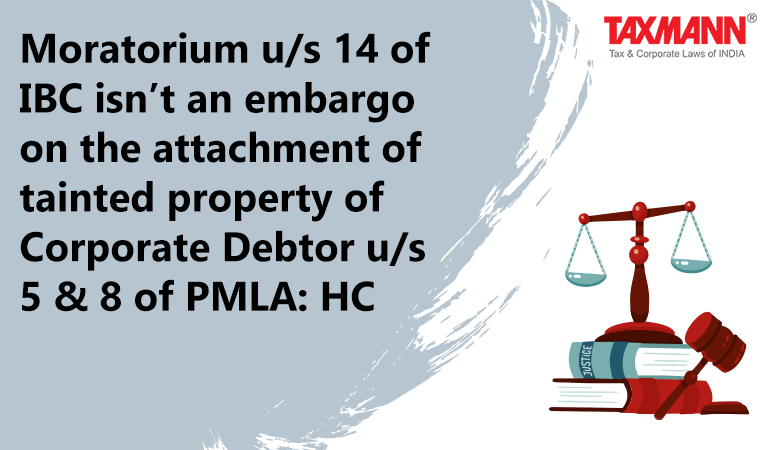Moratorium u/s 14 of IBC isn’t an embargo on the attachment of tainted property of Corporate Debtor u/s 5 & 8 of PMLA: HC
- Blog|News|FEMA & Banking|
- 2 Min Read
- By Taxmann
- |
- Last Updated on 18 November, 2022
Case Details: Rajiv Chakraborty Resolution Professional of Eiel v. Directorate of Enforcement - [2022] 145 taxmann.com 21 (Delhi)
Judiciary and Counsel Details
-
- Yashwant Varma, J.
- Abhinav Vashisht, Sr. Adv. & Shivank Diddi, Adv. for the Petitioner.
- Zoheb Hossain, Vivek Gurnani & Kavish Garach, Advs. for the Respondent.
Facts of the Case
In the instant case, Rajiv Chakraborty, a Resolution Professional of Era Infra Engineering Limited, challenged the orders of attachment passed by the ED under PMLA before the High Court. The challenge to the orders of attachment was essentially founded on the provisions of Section 14 of the IBC contending that once the moratorium had come into effect, the ED stood denuded of jurisdiction to exercise powers under the PMLA.
The question before the Delhi High Court was whether Moratorium u/s 14 of IBC is an embargo on attachment of tainted property of CD under sections 5 &8 of PMLA?
High Court Held
The Delhi High Court ruled that Moratorium u/s 14 of IBC would not affect attachment of tainted property of CD under sections 5 &8 of PMLA. Moratorium u/s 14 of IBC would not affect attachment of property under sections 5 & 8 of PMLA notwithstanding the pendency of CIRP as such attachment is not an action for enforcement of debt.
Attachment under the PMLA is not an attachment for debt but principally a measure to deprive an entity of property and assets which comprise proceeds of crime.
“In any case, since the act of attachment does not result in the effacement of rights in property, it would clearly stand and survive outside the scope of a moratorium or an action relating to an action in respect of a debt due or payable”
Court said
The Court ruled that the principle that “latter Act shall prevail” is not an inviolable rule applicable in case of conflict of two special statutes both having non-obstante clauses. Therefore, by virtue of this principle, one cannot mechanically conclude that moratorium under IBC would gain overriding effect over attachment actions under sections 5 and 8 of PMLA without having regard to section 32A of IBC which was enacted later in 2020 to clarify the extent to which the provisions of the PMLA are to give way to proceedings initiated under the IBC.
“When the Legislature introduced section 32A, it was conscious and aware of the fact that the provisions of the PMLA could be enforced against the properties of a corporate debtor notwithstanding the pendency of the CIRP. Notwithstanding the above, the Legislature chose to structure that provision in a manner that the authorities under the PMLA would cease to have the power to attach or confiscate only when a Resolution Plan had been approved or where a measure towards liquidation had been adopted
The statutory injunct against the invocation or utilisation of the powers available under the PMLA was thus ordained to come into effect only once the trigger events envisaged under Section 32A came into effect.
The Legislature thus in its wisdom chose to place an embargo upon the continuance of criminal proceedings including action of attachment under the PMLA only once a Resolution Plan were approved or a measure in aid of liquidation had been adopted. ”
Court said
Disclaimer: The content/information published on the website is only for general information of the user and shall not be construed as legal advice. While the Taxmann has exercised reasonable efforts to ensure the veracity of information/content published, Taxmann shall be under no liability in any manner whatsoever for incorrect information, if any.

Taxmann Publications has a dedicated in-house Research & Editorial Team. This team consists of a team of Chartered Accountants, Company Secretaries, and Lawyers. This team works under the guidance and supervision of editor-in-chief Mr Rakesh Bhargava.
The Research and Editorial Team is responsible for developing reliable and accurate content for the readers. The team follows the six-sigma approach to achieve the benchmark of zero error in its publications and research platforms. The team ensures that the following publication guidelines are thoroughly followed while developing the content:
- The statutory material is obtained only from the authorized and reliable sources
- All the latest developments in the judicial and legislative fields are covered
- Prepare the analytical write-ups on current, controversial, and important issues to help the readers to understand the concept and its implications
- Every content published by Taxmann is complete, accurate and lucid
- All evidence-based statements are supported with proper reference to Section, Circular No., Notification No. or citations
- The golden rules of grammar, style and consistency are thoroughly followed
- Font and size that’s easy to read and remain consistent across all imprint and digital publications are applied





 CA | CS | CMA
CA | CS | CMA


